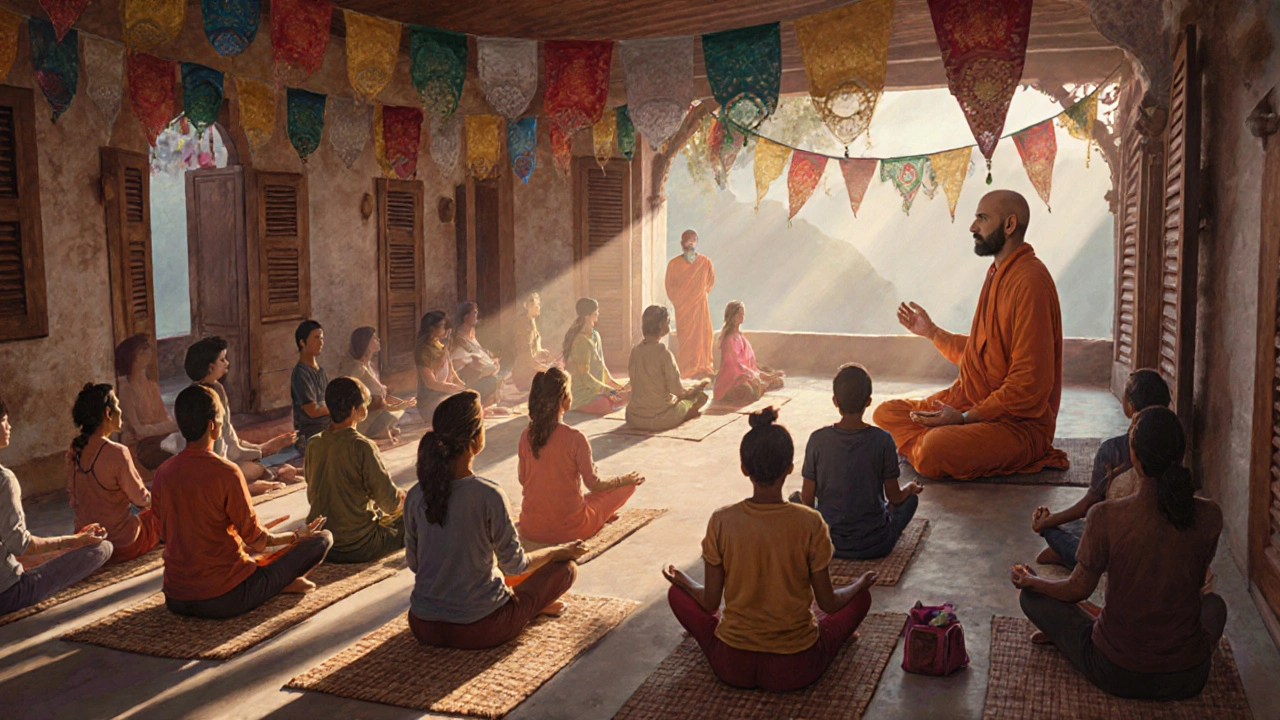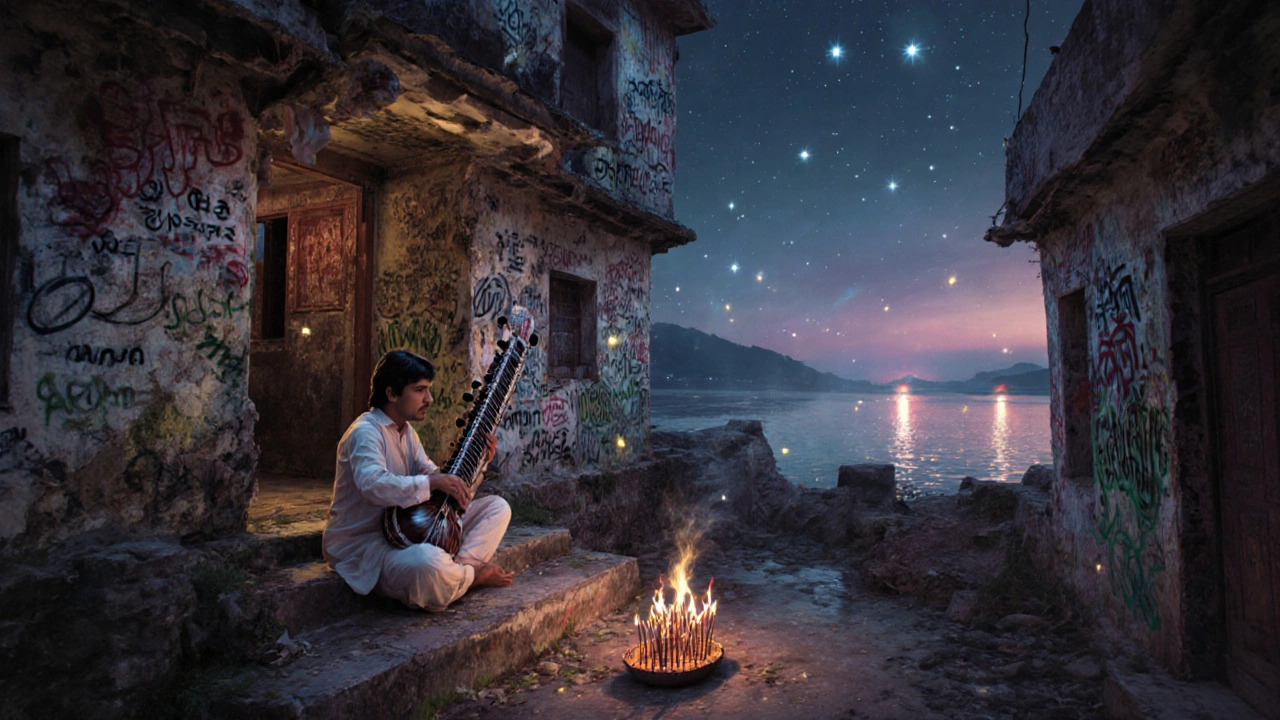Rishikesh Budget Calculator
Plan Your Rishikesh Adventure
Estimate your costs for a trip to Rishikesh based on your preferences. The article mentions costs from ₹5,000 ($60) to ₹20,000 ($240) per week.
Estimated Total Budget
₹0 / $0
This matches the article's range: ₹5,000 - ₹20,000 ($60 - $240) per week
Tip: Book early for November-March as these are peak months
Ask anyone who’s been to Rishikesh why it’s so famous, and you’ll get a dozen different answers. Some will say it’s because of the yoga. Others will tell you it’s the river. A few might mention the ashrams or the music. But if you’ve actually been there-especially in the early morning when the mist rolls off the Ganga and the sound of chanting mixes with the rush of whitewater-you’ll know the truth: Rishikesh is famous because it’s the only place on Earth where all of those things happen at once, and they all feel real.
The Ganga doesn’t just flow here-it defines everything
The Ganges River isn’t just water in Rishikesh. It’s the reason the town exists. Pilgrims have come here for centuries to bathe in its waters, believing it washes away sins. But over the last 50 years, something else happened. The river’s steep drop from the Himalayas into the plains created perfect rapids for rafting. Today, Rishikesh is the only place in India where you can float past ancient temples one hour and tackle Class III and IV rapids the next.
The most popular stretch runs from Shivpuri to Kaudiyala-about 16 kilometers of churning water, narrow gorges, and sudden drops. Local operators run trips year-round, but the best months are October through April. Water levels are high enough for thrills but not dangerous. In 2024, over 250,000 people went rafting here, according to Uttarakhand tourism data. That’s more than any other river adventure spot in the country.
And it’s not just about adrenaline. The river’s spiritual weight adds something you won’t find on the Colorado or the Zambezi. You paddle past ghat steps where people are burning offerings. You stop for tea at a riverside stall run by a sadhu who’s been living here since the 1970s. The water doesn’t just move your body-it moves your mind.
Yoga isn’t just taught here-it’s lived
Rishikesh earned the title ‘Yoga Capital of the World’ for a reason. It’s not a marketing slogan. It’s a fact. More than 1,200 yoga schools and ashrams operate here, from massive institutions like Parmarth Niketan to tiny studios tucked behind fruit stalls. You don’t need to be flexible. You don’t need to believe in anything. All you need is to show up.
Swami Sivananda started teaching here in the 1940s. His disciple, Swami Vishnudevananda, took it global in the 1960s. Then the Beatles came. They didn’t just visit-they stayed. They meditated here, wrote songs, and brought back stories that turned Rishikesh into a magnet for Western seekers. Today, you’ll find students from Japan, Brazil, South Africa, and Germany sitting cross-legged beside locals in the same shala.
Most ashrams offer 7-day courses for under ₹5,000 (about $60). You get three meals a day, basic lodging, and daily classes in asana, pranayama, and meditation. Some even include free yoga teacher training. No credit cards. No apps. Just a mat, a bell, and silence.
It’s not just yoga-it’s the whole lifestyle
Walk through the streets of Rishikesh and you’ll see people in saffron robes, others in leggings and headbands, and everyone in between. The town doesn’t force you into one identity. It lets you choose your pace. You can spend your morning doing sun salutations, your afternoon kayaking, and your evening listening to live sitar music under the stars.
Many of the ashrams serve only vegetarian food. You’ll find vegan cafes, juice bars, and organic bakeries tucked between shops selling prayer beads and handwoven shawls. No alcohol. No drugs. No loud clubs. But that doesn’t mean it’s boring. The energy here is quiet, but it’s alive. You’ll hear laughter in the courtyard, the clink of tea cups at sunrise, and the distant hum of a temple bell.
Even the shopping feels different. You won’t find mass-produced souvenirs. Instead, you’ll find hand-carved wooden elephants, copper singing bowls, and incense made from local herbs. The vendors know your name by day three. They’ll ask if your meditation practice is going well.

The music connection still echoes
The Beatles didn’t just visit Rishikesh-they changed it. In 1968, they came to study Transcendental Meditation with Maharishi Mahesh Yogi. They stayed for weeks. They wrote songs like ‘Dear Prudence’ and ‘Julia’ here. Their presence made Rishikesh the first Indian town to go viral in the West.
Today, the Beatles Ashram-now called Chaurasi Kutia-is open to visitors. The walls are covered in graffiti left by travelers over the decades. Some are messages of peace. Others are scribbled names from people who came to find themselves. The place is crumbling, but that’s part of its power. It’s not a museum. It’s a living relic.
Every Friday night, live music happens at the Ganga Aarti stage. Local musicians play folk tunes, fusion beats, and acoustic versions of classic rock. You’ll hear sitar mixed with guitar. Tabla with drums. No tickets. No crowd control. Just people sitting on the steps, listening, swaying, sometimes crying.
It’s not a destination-it’s a reset
Most travel guides call Rishikesh a ‘spiritual retreat.’ That’s too soft. It’s not about relaxation. It’s about recalibration. People come here broken-from burnout, grief, loss, or just the noise of modern life. They leave different. Not because they found enlightenment. But because they found silence.
You don’t need to become a monk. You don’t need to quit your job. But if you spend five days here-waking with the sun, walking barefoot on stone, drinking warm water, sitting still-you start to notice things you forgot. How your breath feels. How your body moves. How quiet the world can be when you stop trying to fill it with noise.
That’s why Rishikesh is famous. Not because it’s pretty. Not because it’s cheap. Not even because it’s unique. It’s famous because it works. For people who’ve tried everything else, it still does what it’s always done: it gives you back your sense of calm.

What most visitors miss
Most tourists stick to the main road-Lakshman Jhula and Ram Jhula. They take photos, buy souvenirs, and leave. But the real Rishikesh is a 10-minute walk upstream. Head toward the forest trails near Neer Garh Waterfall. Find the small ashram with no sign. Sit on the rocks by the river. Watch the water. Don’t take a photo. Just be there.
Or wake up at 4:30 a.m. and walk to Parmarth Niketan for the Maha Aarti. You’ll be one of maybe 20 people there. The priests chant. The bells ring. The fire glows on the water. No crowds. No phones. Just the river, the sky, and the sound of your own heartbeat.
Is Rishikesh safe for solo travelers?
Yes, Rishikesh is one of the safest places in India for solo travelers, especially for women. The town has a strong spiritual culture that discourages aggressive behavior. Most guesthouses and ashrams have secure dorms, and locals are used to helping visitors. That said, avoid walking alone at night near the riverbanks, and don’t accept rides from strangers. Stick to registered rafting operators and use trusted transport apps like Ola or Uber.
Do I need to be spiritual to enjoy Rishikesh?
No. You don’t need to meditate, chant, or wear white clothes. Many visitors come just for the rafting, the food, or the mountain views. The yoga schools welcome everyone-even people who’ve never tried yoga. The town doesn’t judge. It simply offers space. If you want silence, you’ll find it. If you want adventure, you’ll find that too.
When is the best time to visit Rishikesh?
October to April is ideal. The weather is cool and dry, perfect for outdoor activities. Rafting season runs from late September through May, with peak water levels in October and November. March and April are the busiest months for yoga, so book ashrams early. Avoid July to September-monsoon season brings heavy rains, landslides, and closed roads.
Can I do adventure sports in Rishikesh without experience?
Absolutely. Most rafting companies offer beginner-friendly trips with trained guides and life jackets. The Shivpuri to Kaudiyala route has sections for all levels. You can also try bungee jumping, zip-lining, and camping-all available with full safety briefings. No prior experience needed. Just follow instructions and listen to your guide.
How much should I budget for a week in Rishikesh?
You can do it on ₹5,000 ($60) a week if you stay in a basic ashram dorm, eat simple meals, and skip paid activities. For a more comfortable stay with private rooms, yoga classes, and rafting, plan for ₹15,000-20,000 ($180-240). Flights to Dehradun (the nearest airport) start at ₹4,000 round-trip from Delhi. Rishikesh is one of the most affordable adventure and spiritual destinations in the world.
What to do next
If you’re ready to go, book your stay at least two weeks ahead if you’re coming between November and March. Choose a place near the river but away from the main tourist drag-places like Swarg Ashram or Muni Ki Reti offer peace without isolation. Pack light: breathable clothes, a good pair of sandals, a reusable water bottle, and an open mind.
And don’t plan to leave the same person you were when you arrived. Rishikesh doesn’t change you. It just reminds you of who you were before the noise started.
